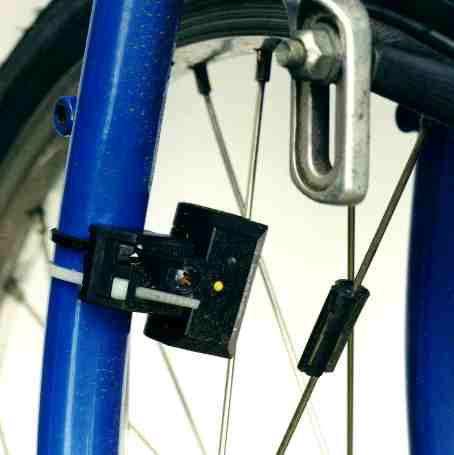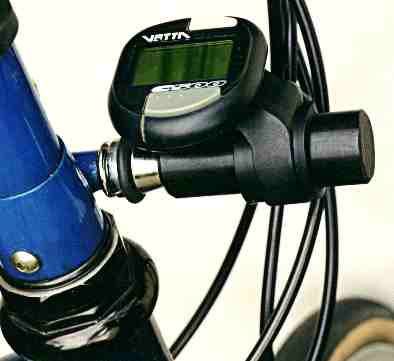 Sigma
700 (earlier model) with RCS mounting kit, mounted on the bars. The
mounting unit contains a sensor, and hence also needs another battery,
making it rather bulky.
Sigma
700 (earlier model) with RCS mounting kit, mounted on the bars. The
mounting unit contains a sensor, and hence also needs another battery,
making it rather bulky.Fitting a cycle computer to a Bike Friday raises two special concerns: will the computer work with the smaller wheels, and can it be fitted without interfering with the folding?
I've used quite a number of different types of computer with the Bike Friday and other small wheeled bicycles over the years, and all the ones I've tried could be calibrated to cope with 16 inch wheels, so the 20 inch ones, whether the 406 or 451 versions, presented no problems. However, I've heard a rumour, which I haven't personally confirmed, that the new Shimano system available for some of their groupsets, which integrates gear change information, speedometer and other functions, won't handle smaller wheel sizes, including the Bike Friday sizes. That excepted, it seems likely that most others will, but it's worth checking before you spend your money. The Sigma (700 and 800), Cateye (Mity 2 and cordless), Vetta (C500 cordless), and a couple of early Avocet models are the ones I have personally used successfully with small wheelers (Moultons, Brompton and Birdy as well as Bike Fridays).
The calibration factors listed in the manuals with the computers rarely include our wheel sizes, but an equation is provided to allow you to work out the factor for yourself. It usually involves measuring the distance rolled by the wheel in one revolution. Suitably armed with the manual, you then need to work out the combination of buttons to press to set the calibration factor on the computer. Don't lose the manual, or when the time comes to replace the battery you will have real problems setting the calibration factor again, as unfortunately it's usually lost when you do this. I usually write the factor on the manual when I originally calculate it, to save re-measuring the wheel and performing the calculation again when the battery is changed.
The usual place to put the computer readout is on the handlebars, which is the most convenient place for seeing the display and pressing the buttons which control which particular values are displayed. However, if you have a computer with a cable linking the wheel sensor to the head, this means having some means of separating the cable when the bars are removed for folding. On the computer originally fitted to my NWT I fitted a small jack plug and in-line socket for this purpose. This is not a very neat solution, and it is all too easy to damage the connectors, or for action to become intermittent if the connectors get dirty. The alternative is to fit a cordless computer, but this is not without problems. The difficulty lies in the distance between the wheel sensor and the computer mounted on the bars, which is much greater than on a bicycle with larger wheels. Many of the cordless computers won't work in these circumstances, including the Cateye Cordless and Vetta C500. One which DOES work (at least on the bikes I have tried it on - there might be problems if you have a particularly tall stem) is the Sigma. In the case of the Sigma, you use any of the standard Sigma computers, but purchase the remote mounting kit, which replaces the wheel sensor and the handlebar mounting bracket. There are a number of drawbacks, though. Firstly I don't much like the system of mounting the sensor and bar bracket used by Sigma, which involves a not very positive strap (though it does make fitting it to a bike with unusually shaped forks, like the Birdy, feasible). Secondly there are batteries in the sensor, the mounting bracket AND the computer itself. Thirdly, you must remember to press a button on the bracket to start the thing working at the beginning of the ride. Finally, the bar mounting bracket is a clumsy affair, since it contains a sensor as well as the batteries (this is the down side of the wireless system being built into a universal bracket, rather than into the computer itself. I must say that I also don't much like the buttons for selecting he display on the Sigma, which are clumsy to operate, and which are apt to move the not very positively mounted bracket when you press them. On some models it is too easy to zero the unit while removing it from the bike - the latest 700 overcomes this particular problem. Another drawback with the Sigma is that although it is sensitive enough to work with the greater wheel to bar distance of the Bike Friday, this also makes it a bit prone to interference - take it off the bike when travelling by electric train, or you may find that it has recorded very high mileages at amazing speeds during the journey! There is an alternative method of mounting the computer on the Bike Friday, which allows less sensitive cordless models to be used successfully. This involves a small bracket which mounts on the end of the stem clamp at the base of the stem. This is quite an ingenious solution, but it does add a little weight, it is a bit fiddly to adjust to maintain the correct angle of view, it can be knocked with the knee when mounting, it is more vulnerable to other knocks, it is awkward to press the control buttons on the computer, and the display is less legible - particularly if you have a very short forward extension on the bars, so that the computer is concealed by the bars when riding. Although I don't like the Sigma, I personally prefer it to using this bracket.
 Sigma
700 (earlier model) with RCS mounting kit, mounted on the bars. The
mounting unit contains a sensor, and hence also needs another battery,
making it rather bulky.
Sigma
700 (earlier model) with RCS mounting kit, mounted on the bars. The
mounting unit contains a sensor, and hence also needs another battery,
making it rather bulky.
 The
current Sigma 700, with revised controls
The
current Sigma 700, with revised controls
 The
Sigma RCS sensor unit mounted on the forks - bulky, because like other
wire less sensors it needs to incorporate a battery
The
Sigma RCS sensor unit mounted on the forks - bulky, because like other
wire less sensors it needs to incorporate a battery
 The
Vetta computer is specifically designed as a cordless unit, and is more
compact. But it won't operate on a small wheeler at the normal wheel
sensor to computer distance. Here it is shown mounted on the special Bike
Friday mounting at the base of the steering column.
The
Vetta computer is specifically designed as a cordless unit, and is more
compact. But it won't operate on a small wheeler at the normal wheel
sensor to computer distance. Here it is shown mounted on the special Bike
Friday mounting at the base of the steering column.
I have only been able to write about my own experiences here. I do hope that readers tell us about their experiences, so that we can extend the information provided here.
Additional comments on the Vetta C500
By Peter Johnson
I've successfully fitted and used a Vetta C500 cordless computer on my Pocket Rocket for the last 600 miles without any special fitting kits.
The instructions didn't specify any maximum distance between transmitter and computer head but I realised that the extra distance due to the small wheels might be a problem. I therefore mounted the little magnet in the upper part of the X formed by the spokes instead of the lower part, thereby shifting it three quarters of an inch upwards. In fact, the screw attachment of the magnet is so secure, there would be nothing to stop you mounting it even closer to the rim on a single spoke, even though you would lose the bracing effect of the crossed spokes. The distance between the top of the transmitter and the bottom of the computer head mounted on the handlebars is twenty four and a half inches. I thought I might have to move it closer but tried it out and it worked perfectly right from the start.
The Vetta is a super little computer with big clear readout. Unlike the otherwise excellent Cateye Mity 2 it replaced (due to me snapping the wire while folding), it is impossible to accidentally trip back to zero. Just leaning forward and brushing against the Mity with its two protruding buttons was enough to trip it. As the Vetta can now be obtained at several mail order discount places for less than thirty pounds, I reckon it is well worth considering by Bike Friday owners.
Peter's experience with the Vetta is interesting, because it is the same model as was fitted on my Pocket Rocket, and which failed to operate with the head mounted on the bars. The sensor was mounted quite close to the outer diameter of the wheel to keep it as close to the computer as possible - about 24 inches as in Peter's case. I can only suggest that the Vetta is probably operating close to its limits, and with longer stems and some examples of the computer it may not work on the bars, while with shorter stems and some other examples, it will be OK. This does also raise the question of what safety margin there is with other makes, including the Sigma I mentioned. I've only tried the one Sigma, but I suspect that it is much more sensitive than most, which is supported by the fact that it essily picks up signals it's not intended to - like when carrying the bike on electric trains, when it is essentil to remove the head while on the train or it will record a lot of spurious miles, due presumably to electrical noise.
Return to home page | Return to Technical Support page | Return to User Group UK page | Go to Bike Friday USA web site
Last updated: 6 October 1998
Copyright (C)1998 Ferrets Anonymous